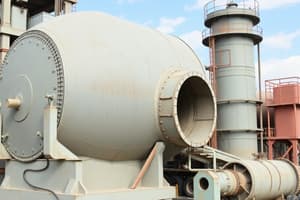Podcast
Questions and Answers
What are the two types of materials required for the manufacture of Portland cement?
What are the two types of materials required for the manufacture of Portland cement?
Calcareous materials and Argillaceous materials
At what temperature is the raw material mixture burned in a kiln during the manufacture of Portland cement?
At what temperature is the raw material mixture burned in a kiln during the manufacture of Portland cement?
About 1300 to 1500°C
What is the purpose of adding gypsum to the cement during its manufacture?
What is the purpose of adding gypsum to the cement during its manufacture?
To control the time of set of the cement
What is the final product formed after grinding the clinker with gypsum?
What is the final product formed after grinding the clinker with gypsum?
What are the four stages involved in the manufacture of Portland cement?
What are the four stages involved in the manufacture of Portland cement?
What is the shape of the clinker formed during the manufacture of Portland cement?
What is the shape of the clinker formed during the manufacture of Portland cement?
What is the primary difference between the wet, dry, and semidry processes of cement manufacture?
What is the primary difference between the wet, dry, and semidry processes of cement manufacture?
What is the purpose of screens in the processing of soft materials?
What is the purpose of screens in the processing of soft materials?
How is thorough mixing of dry materials in silos ensured in the dry process?
How is thorough mixing of dry materials in silos ensured in the dry process?
What is the typical water content of the slurry in the wet process before filtering?
What is the typical water content of the slurry in the wet process before filtering?
What is the purpose of filtering the slurry in the wet process?
What is the purpose of filtering the slurry in the wet process?
What is the purpose of blending in the cement manufacturing process?
What is the purpose of blending in the cement manufacturing process?
Flashcards are hidden until you start studying
Study Notes
Manufacture of Portland Cement
- Raw materials required: calcareous (containing calcium carbonate) materials like limestone or chalk, and argillaceous materials like shale or clay
- Process consists of: grinding raw materials, mixing them in certain proportions, burning them in a kiln, and grinding the resulting clinker with gypsum to form Portland cement
Four Stages of Manufacture
- Crushing and grinding the raw materials
- Blending the materials in the correct proportions
- Burning the prepared mix in a kiln
- Grinding the burned product (clinker) with gypsum
Grinding and Crushing
- Soft materials are broken down by vigorous stirring with water in wash mills, producing a fine slurry
- Hard materials are crushed in two stages and then ground in rotating cylindrical ball or tube mills containing steel grinding balls
- Grinding can be done wet or dry, depending on the process
Blending
- Chemical composition of cement is controlled by selective quarrying and processing of raw materials
- Finer control is achieved by blending materials from two or more batches with slightly different compositions
- Dry process: materials are stored in silos and mixed by agitation and compressed air
- Wet process: slurry tanks are stirred by mechanical means or compressed air or both
Studying That Suits You
Use AI to generate personalized quizzes and flashcards to suit your learning preferences.




